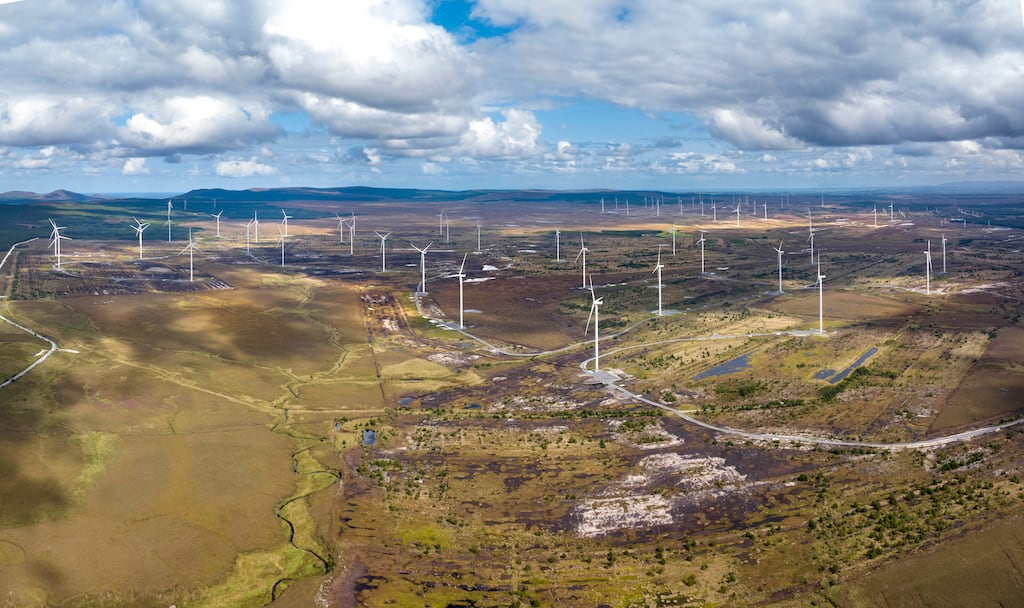The ESB and Bord na Móna on Friday marked the completion of Ireland’s largest wind farm in North Mayo which has installed capacity of 192 megawatts, meeting the electricity needs of some 140,000 homes.
Oweninny wind farm was delivered in two phases with a total investment of €320 million. In 2019, 29 turbines were erected while the second phase, consisting of 31 turbines, has now entered commercial operation. It was financed by a consortium of banks including AIB, BNP Paribas and the EIB.
Minister for Climate and Energy Eamon Ryan said: “This really is a significant day for Ireland, and for Mayo ... this flagship project showcases what we can achieve, and what must be done, to deliver the clean energy we need to reduce our dependence on imported fossil fuel.”
ESB chief executive Paddy Hayes said the project was an important element in delivering its net zero emissions by 2040 target.
READ MORE
“Oweninny builds on our long-standing history of delivering projects of scale in North Mayo and the wider West of Ireland region. Renewable electricity reduces Ireland’s dependence on gas markets and contributes to Ireland’s ambitious climate action plan targets, supporting a net-zero future for the customers and communities we serve.”
The project was an important milestone for Bord na Móna “as it underpins our dedication to operate as climate solutions and renewable energy leader in Ireland following the completion of our brown to green transition at the end of 2023″, its chief executive Tom Donnellan said. “In Ireland, we are putting more renewables on the grid than ever before, which is essential if we are to meet our targets of achieving 80 per cent renewable energy by 2030.”
Located between Crossmolina and Bangor Erris, the development adjoins Ireland’s first commercial wind farm, Bord na Móna’s Bellacorrick, which was built in 1992 when the late Eddie O’Connor was chief executive – and remains in operation.
The wind farm has a community benefit fund that will invest €18m towards not-for-profit organisations such as community and voluntary groups, charities, social enterprises and clubs and societies which supports community-based initiatives and improvement projects.
The site includes a €3m visitor interpretative centre focusing on the science, engineering and technology behind renewable energy, while raising awareness of climate change and considering the landscape in which the wind farm is based.
Meanwhile Minister for Enterprise, Trade and Employment Simon Coveney has published the State’s first industrial strategy for offshore wind energy, which sets out 40 actions with a view to creating 5,000 jobs by 2030.
Its overarching objective is to maximise the industrial development opportunity arising from offshore wind energy production while establishing “clean, green, renewable industries of the future”. The actions for implementation in 2024 and 2025 were developed in collaboration with other Government departments and agencies.
On offshore wind supply chains, it commits to building capacity and capability to deliver on a 37 gigawatt target by 2050 “and give Ireland an edge in exporting products and services related to offshore wind energy”. It will support research, development and innovation “to give Ireland a competitive cutting edge in new technology and know-how for the sector”.
This will be done by pursuing balanced regional economic development, it says, including development of a suite of green energy industrial parks, which can attract major foreign direct investment, establish new indigenous green businesses and serve as test beds for green technological innovation.
With its marine territory some 10 times the size of its land area, the strategy will harness the economic potential that this represents, Mr Coveney said – “and there is a particular opportunity to establish Ireland as a world leader in floating offshore wind energy”.
“Electricity demand in Ireland is expected to double by 2050. While offshore renewable energy is a nascent industry in Ireland, the potential benefits are multifaceted and cannot be overstated,” Mr Coveney said. “Offshore renewable energy, particularly offshore wind, will add another layer to our economic future, provide energy security in uncertain times and drive the charge towards decarbonisation and ending our reliance on fossil fuels.”
Commenting on the strategy Taoiseach Leo Varadkar said: “We need to work now to make sure we have the necessary infrastructure, supply chains and skills to really take advantage of Ireland’s offshore wind potential.”
“Ireland can and will become energy independent, bringing down our energy bills and reliance on other countries for fuel, while creating thousands of jobs across the country,” he added.
Minister for Climate and Energy Eamon Ryan said: “Ireland is already a global leader for installed onshore wind power capacity and for the integration of variable renewable electricity on to the grid. Powering Prosperity sets out how we can also become industry leaders in the deployment of offshore wind.”
Over the next month, the Government will publish its first draft designated maritime area plan (DMAP) for the South coast and a future framework for offshore renewable energy policy statement. “This maps out how Ireland can create a flagship offshore renewable energy sector to achieve our climate and energy targets beyond 2030, while also bolstering the security and prosperity of the State,” Mr Ryan said.
- Listen to our Inside Politics Podcast for the latest analysis and chat
- Sign up for push alerts and have the best news, analysis and comment delivered directly to your phone
- Find The Irish Times on WhatsApp and stay up to date















